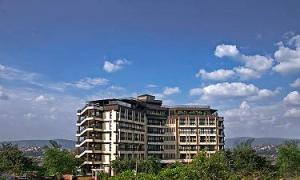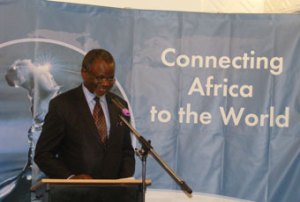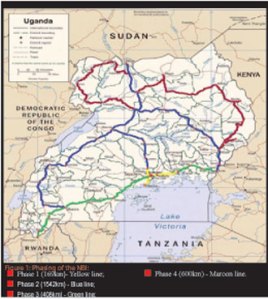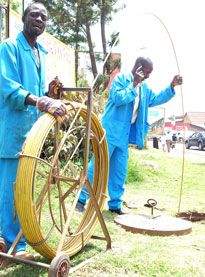Analysis
The National Fibre Optic Backbone Project has recently been the discussion topic in the Parliamentary Committee on ICT and the Ministry of ICT where clarifications on the project were sought. There is evident need to articulate what the project is about, what it means to the country and the region together with a clear understanding of the technology and related financial aspects.

Dr. Ham Mulira - Uganda's ICT Chief
In the current business environment, Information Systems, the Internet and global communication networks are creating new opportunities for organisational coordination and innovation. Such systems, used in government/governance, can extend reach and effectiveness of both to remote locations, and improve service delivery to citizens. Current practice has been satellite based communication links, but the associated costs are prohibitive and result in minimised access size of paths, (bandwidth) leading to slow Internet speeds, for example.
In order to address the above, the government of Uganda, through the Ministry of ICT, decided to implement the National Data Transmission Backbone Infrastructure and e-Government Infrastructure (NBI/EGI) project for high speed communications. This entails laying of Fibre Optic Cables and installation of related equipment, which include switches, optical transmission equipment, data communication equipment, fixed network equipment, video equipment, computers, servers, training and service.
Ultimately, the fibre optic cable will link Uganda to the submarine cables on the East African coast providing access to the rest of the world through Kenya. The project has two key components namely-, the National Backbone Infrastructure (NBI) and the e-Government Infrastructure (EGI), to be implemented in three Phases at a total contract cost of $106m.
Phase I was for e-Government Infrastructure and its objective was to provide connectivity to government ministries and departments including high-tech communication services called TETRA for Uganda Police with a total cost of $30 million. It should be noted that this component was designed for internal government use, commonly referred to as Government-to-Government services and not for general public usage. Since the phase was to connect ministries, only Kampala, Entebbe, Jinja and Bombo were connected with a total distance of 168 km of laid fibre and related equipment.
Phases II and III of the NBI constitute the remaining areas of the country (see map figure 1) including establishing a high tech government data centre. A backbone is like a digital highway or main road, it covers enough locations strategically spaced across the country from which links can be established to serve the surrounding areas.
Similarities can be drawn with the telecommunication masts strategically located to establish communication signals that serve the surrounding areas. You do not have to stand near a telecom mast to make a phone call. The NBI is intended to ensure availability of high bandwidth data connection across Uganda at reasonable rates and can be used for government service delivery, schools, hospitals, businesses, homes and ultimately the general public. When mobile telephones were introduced, the costs and services were unaffordable to the majority.
As the technology evolved and infrastructure spread, a dramatic cost reduction led to increased affordability by the public with over nine million customers today. In addition, a variety of innovative services using the mobile phone have been introduced. Similarly, when the submarine cables are linked to the NBI there shall be widespread availability of high speed communications at a fraction of current costs leading to Internet and related services being affordably accessible to the public. Phases II and III shall cover 1,900 kms at a cost of $61 million and $15 million, respectively.
In planning, designing and sizing a national backbone project many factors have to be considered. These include the terrain, geographical spread/coverage, fibre capacity to meet potential demand based on size of the target population, costs of civil works amongst others. For example, laying 10km of fibre in the countryside is quite different to laying 10km of cable in the built-up urban areas.
In terms of geographical spread/coverage, the technology used to cover communication signals over a long distance between sites is different from that across areas that are nearer to each other. In comparison, the electric wire for a light bulb hanging in a room is not what determines the intensity of light emitted, it is the power of the bulb that does so, hence, a wider room requires higher wattage/power. The demand in terms of numbers of potential users determines the power of the fibre cable in terms of traffic it can handle simultaneously. It is, therefore, erroneous to simply compare costs of one project to another without considering a multitude of factors.
In the discussions, direct comparison of costs between the Uganda project and that of Rwanda were made asking why the Ugandan one is $126 million for 2,100 kms and the latter $38 million for 2,300 kms (in some reports it is 1,300 kms).
First, the contracted cost of the Uganda project implementation for the laying of the fibre, equipment and training, inter alia, as per the loan, has a total of $54 million for the e-Government component ($30 million in Phase I and $24 million in Phases II & III) and the National Backbone Infrastructure is $62 million totalling to $106 million. The additional $20 million is counterpart funding by government, which includes taxes and clearing.
As per standard practice, taxes are always budgeted for in government procurements, although they are not actual physical money paid out, they are accounting book entries. The figure of $38 million for the Rwanda project, which has been continuously reflected in the discussions is the contract cost and may not reflect the other costs such as taxes and clearing. The comparison should strictly be on the NBI components which is the $62 million against the $38 million since the Rwanda project does not include the e-Government infrastructure component.
National backbone projects are designed to cater for current and future needs of the country for several decades since once the fibre is laid the traffic capacity can be increased by changing the devices that send the traffic not the fibre. In the light bulb wire example, it is like changing to a more powerful light bulb not the wire. The cable capacity is the amount of traffic, which it can handle simultaneously and it is measured as the number of signals per second or Bits Per second.
Each country bases its requirements on the potential demand, which is determined by the size of population and geographical spread. Consequently, the technologies used are different. In Uganda, because of the relatively larger geographical spread and a larger population with potentially higher traffic demand, there is need to send signals across sites, which are relatively far from each other whilst catering for higher traffic.
For example, a signal from Kampala to Gulu, which is about 330kms requires more intermediary “boosters” to ensure that the signal does not lose strength. The fibre cable laid is 24 core or strands of fibre and in Uganda the technology for the stations is largely what is called Dense Wavelength Division Multiplexing (DWDM), which combines and transmits multiple signals simultaneously using the same fibre, in effect, transforming one fibre into multiple virtual fibres increasing the capacity of the physical cable.
This technology has a traffic carrying capacity of 2.5 Gb/s or two and a half billion signals per second on one fibre strand. The alternate technology is called Synchronous Digital Hierarchy (SDH), which has a capacity of 155.2 million signals per second. In other words, DWDM has 16 times more capacity. The current population in Uganda is about 30 million and estimated to rise to over 40 million by 2017 according to the Uganda Bureau of Statistics with a wider geographical spread. There is, therefore, more need for the DWDM technology, hence, relatively higher costs.
Another aspect of the discussion is the cutting of the cable. In laying fibre cable, just like other projects with routes on main roads, certain standards are set including the distance off the main road and depth of the cable. Implementation of the NBI coincided with major road works along certain routes, especially, Jinja and Bombo roads leading to cable being accidentally cut in some cases.
This issue was addressed through joint coordination between the Ministry of ICT and the Ministry of Works and Housing together with relevant agencies but the problem would still re-occur on ground but systematically resolved. However, the NBI was designed with Resilient Packet Rings to ensure that should a breakdown occur, the traffic can automatically be re-routed.
In conclusion, the NBI/EGI project is vital in preparing the country for full participation in the new Information Age. All countries in the region are at various stages of implementing national backbones which will ultimately link into each other for regional communications connectivity. As in any project, it has had expected setbacks but these would continue to be addressed and resolved.
A comparison based on total project cost divided by total distance is misleading as has been portrayed above. The Table shows a comparison of submarine cables being built on the east coast of Africa. In fact, using such an approach leads to known costs per km ranging from $15,000 to US$ 500,000 per km depending on location, from a countryside project to New York City.
It is unfortunate to state that costs were inflated a conclusion based on a simple comparison of two project costs. Not only is this categorically untrue but also makes one wonder how such statements can be made with impunity totally disregarding the significant contribution of a number of people who have played roles in a professional and transparent manner to make this project a success.
Uganda was the first in the region to implement the e-Government Infrastructure with voice, data and video communications across government and delegations from many African countries visited the project to understudy it. In other countries such national achievements are recognised with pride and built upon not ridiculed, we should always endeavour to objectively assess such matters in the task of national development.
The writer is the Senior Presidential Advisor on ICT




